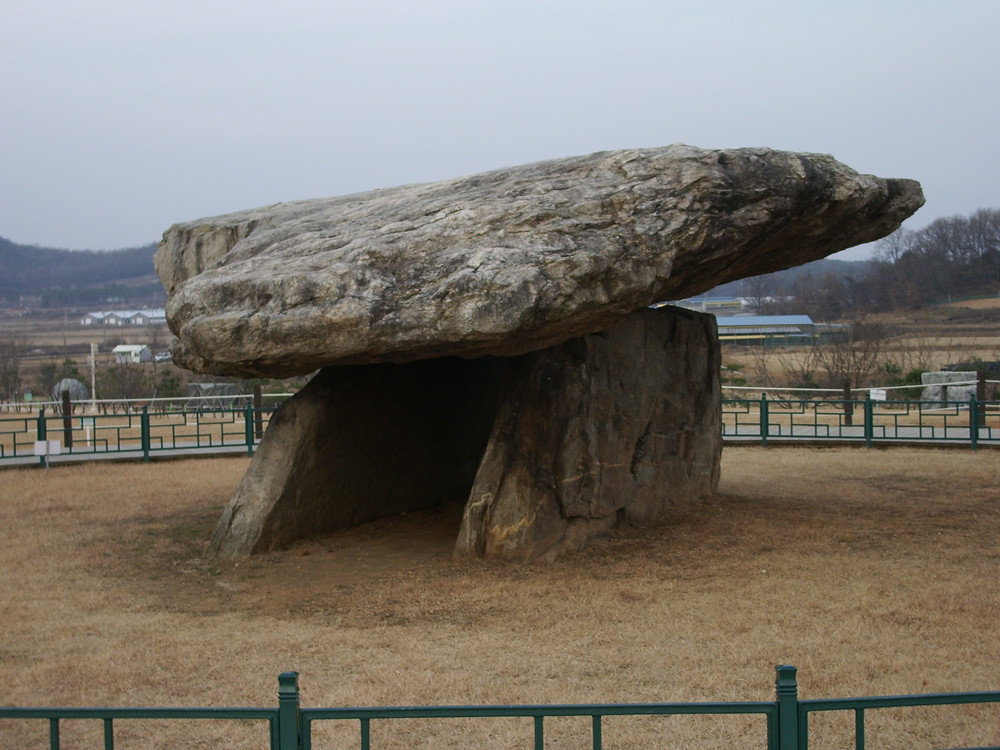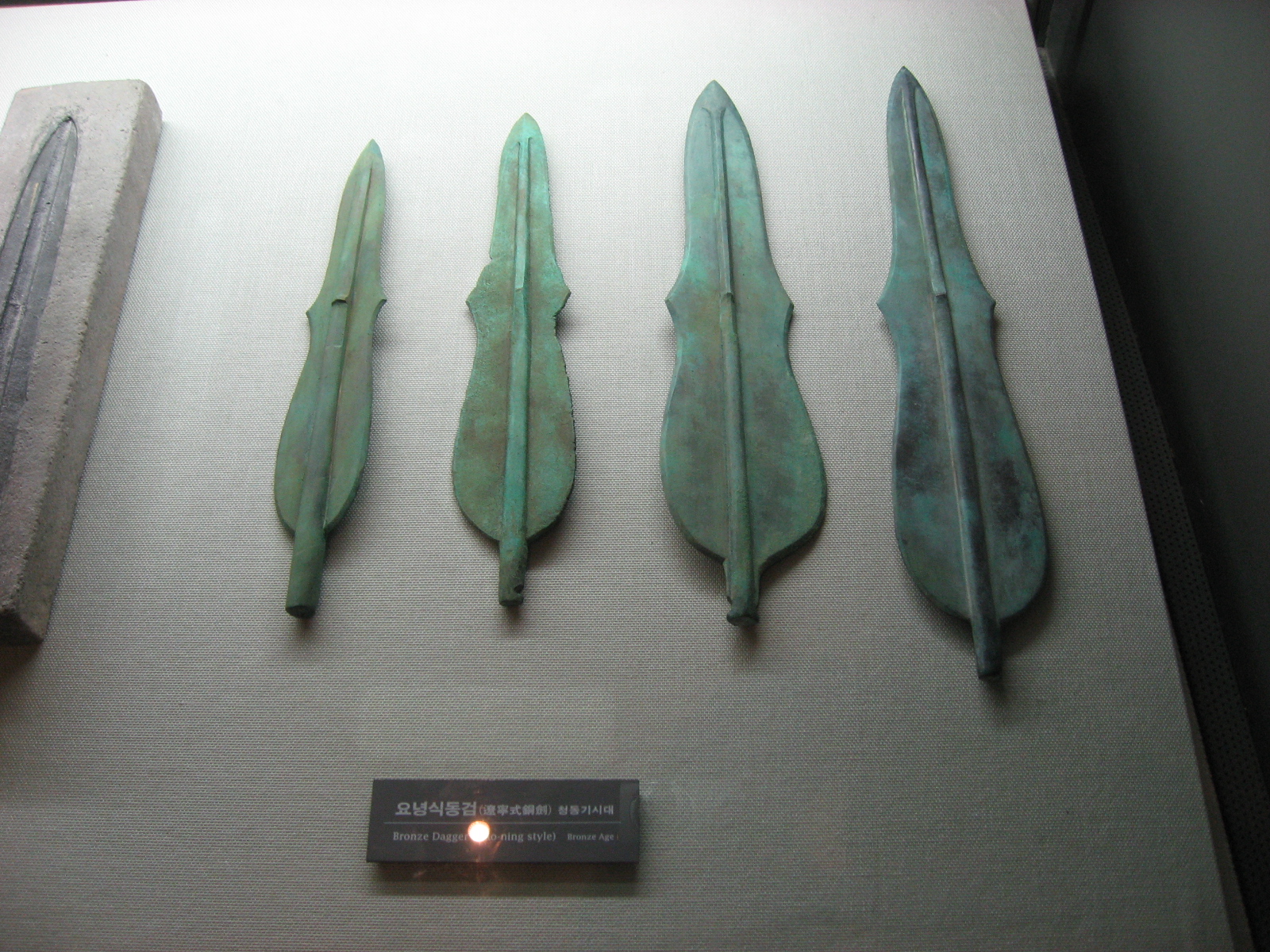3.5: Bronze Age- Gojoseon - Korea (2333 BCE – 108 BCE)
- Page ID
- 219969
\( \newcommand{\vecs}[1]{\overset { \scriptstyle \rightharpoonup} {\mathbf{#1}} } \)
\( \newcommand{\vecd}[1]{\overset{-\!-\!\rightharpoonup}{\vphantom{a}\smash {#1}}} \)
\( \newcommand{\id}{\mathrm{id}}\) \( \newcommand{\Span}{\mathrm{span}}\)
( \newcommand{\kernel}{\mathrm{null}\,}\) \( \newcommand{\range}{\mathrm{range}\,}\)
\( \newcommand{\RealPart}{\mathrm{Re}}\) \( \newcommand{\ImaginaryPart}{\mathrm{Im}}\)
\( \newcommand{\Argument}{\mathrm{Arg}}\) \( \newcommand{\norm}[1]{\| #1 \|}\)
\( \newcommand{\inner}[2]{\langle #1, #2 \rangle}\)
\( \newcommand{\Span}{\mathrm{span}}\)
\( \newcommand{\id}{\mathrm{id}}\)
\( \newcommand{\Span}{\mathrm{span}}\)
\( \newcommand{\kernel}{\mathrm{null}\,}\)
\( \newcommand{\range}{\mathrm{range}\,}\)
\( \newcommand{\RealPart}{\mathrm{Re}}\)
\( \newcommand{\ImaginaryPart}{\mathrm{Im}}\)
\( \newcommand{\Argument}{\mathrm{Arg}}\)
\( \newcommand{\norm}[1]{\| #1 \|}\)
\( \newcommand{\inner}[2]{\langle #1, #2 \rangle}\)
\( \newcommand{\Span}{\mathrm{span}}\) \( \newcommand{\AA}{\unicode[.8,0]{x212B}}\)
\( \newcommand{\vectorA}[1]{\vec{#1}} % arrow\)
\( \newcommand{\vectorAt}[1]{\vec{\text{#1}}} % arrow\)
\( \newcommand{\vectorB}[1]{\overset { \scriptstyle \rightharpoonup} {\mathbf{#1}} } \)
\( \newcommand{\vectorC}[1]{\textbf{#1}} \)
\( \newcommand{\vectorD}[1]{\overrightarrow{#1}} \)
\( \newcommand{\vectorDt}[1]{\overrightarrow{\text{#1}}} \)
\( \newcommand{\vectE}[1]{\overset{-\!-\!\rightharpoonup}{\vphantom{a}\smash{\mathbf {#1}}}} \)
\( \newcommand{\vecs}[1]{\overset { \scriptstyle \rightharpoonup} {\mathbf{#1}} } \)
\( \newcommand{\vecd}[1]{\overset{-\!-\!\rightharpoonup}{\vphantom{a}\smash {#1}}} \)
\(\newcommand{\avec}{\mathbf a}\) \(\newcommand{\bvec}{\mathbf b}\) \(\newcommand{\cvec}{\mathbf c}\) \(\newcommand{\dvec}{\mathbf d}\) \(\newcommand{\dtil}{\widetilde{\mathbf d}}\) \(\newcommand{\evec}{\mathbf e}\) \(\newcommand{\fvec}{\mathbf f}\) \(\newcommand{\nvec}{\mathbf n}\) \(\newcommand{\pvec}{\mathbf p}\) \(\newcommand{\qvec}{\mathbf q}\) \(\newcommand{\svec}{\mathbf s}\) \(\newcommand{\tvec}{\mathbf t}\) \(\newcommand{\uvec}{\mathbf u}\) \(\newcommand{\vvec}{\mathbf v}\) \(\newcommand{\wvec}{\mathbf w}\) \(\newcommand{\xvec}{\mathbf x}\) \(\newcommand{\yvec}{\mathbf y}\) \(\newcommand{\zvec}{\mathbf z}\) \(\newcommand{\rvec}{\mathbf r}\) \(\newcommand{\mvec}{\mathbf m}\) \(\newcommand{\zerovec}{\mathbf 0}\) \(\newcommand{\onevec}{\mathbf 1}\) \(\newcommand{\real}{\mathbb R}\) \(\newcommand{\twovec}[2]{\left[\begin{array}{r}#1 \\ #2 \end{array}\right]}\) \(\newcommand{\ctwovec}[2]{\left[\begin{array}{c}#1 \\ #2 \end{array}\right]}\) \(\newcommand{\threevec}[3]{\left[\begin{array}{r}#1 \\ #2 \\ #3 \end{array}\right]}\) \(\newcommand{\cthreevec}[3]{\left[\begin{array}{c}#1 \\ #2 \\ #3 \end{array}\right]}\) \(\newcommand{\fourvec}[4]{\left[\begin{array}{r}#1 \\ #2 \\ #3 \\ #4 \end{array}\right]}\) \(\newcommand{\cfourvec}[4]{\left[\begin{array}{c}#1 \\ #2 \\ #3 \\ #4 \end{array}\right]}\) \(\newcommand{\fivevec}[5]{\left[\begin{array}{r}#1 \\ #2 \\ #3 \\ #4 \\ #5 \\ \end{array}\right]}\) \(\newcommand{\cfivevec}[5]{\left[\begin{array}{c}#1 \\ #2 \\ #3 \\ #4 \\ #5 \\ \end{array}\right]}\) \(\newcommand{\mattwo}[4]{\left[\begin{array}{rr}#1 \amp #2 \\ #3 \amp #4 \\ \end{array}\right]}\) \(\newcommand{\laspan}[1]{\text{Span}\{#1\}}\) \(\newcommand{\bcal}{\cal B}\) \(\newcommand{\ccal}{\cal C}\) \(\newcommand{\scal}{\cal S}\) \(\newcommand{\wcal}{\cal W}\) \(\newcommand{\ecal}{\cal E}\) \(\newcommand{\coords}[2]{\left\{#1\right\}_{#2}}\) \(\newcommand{\gray}[1]{\color{gray}{#1}}\) \(\newcommand{\lgray}[1]{\color{lightgray}{#1}}\) \(\newcommand{\rank}{\operatorname{rank}}\) \(\newcommand{\row}{\text{Row}}\) \(\newcommand{\col}{\text{Col}}\) \(\renewcommand{\row}{\text{Row}}\) \(\newcommand{\nul}{\text{Nul}}\) \(\newcommand{\var}{\text{Var}}\) \(\newcommand{\corr}{\text{corr}}\) \(\newcommand{\len}[1]{\left|#1\right|}\) \(\newcommand{\bbar}{\overline{\bvec}}\) \(\newcommand{\bhat}{\widehat{\bvec}}\) \(\newcommand{\bperp}{\bvec^\perp}\) \(\newcommand{\xhat}{\widehat{\xvec}}\) \(\newcommand{\vhat}{\widehat{\vvec}}\) \(\newcommand{\uhat}{\widehat{\uvec}}\) \(\newcommand{\what}{\widehat{\wvec}}\) \(\newcommand{\Sighat}{\widehat{\Sigma}}\) \(\newcommand{\lt}{<}\) \(\newcommand{\gt}{>}\) \(\newcommand{\amp}{&}\) \(\definecolor{fillinmathshade}{gray}{0.9}\)Introduction
During the Bronze Age, different clans began to merge into larger groups. The tribes established Gojoseon (3.5.1), considered the first recognizable state of Korea. The various factions theoretically defined Dangun Wanggeom as the political and spiritual leader. Some accounts of the period demonstrate that the people believed in the King of Heaven, and bears were the object of worship. A well-formed ruling class developed, and the powerful kings bequeathed the throne to their sons. The Gojoseon flourished and successfully repelled challenges from the Chinese dynasties of Yan, Qin, and Han. The war with the Han lasted almost a year and started the internal infighting, leading to Gojoseon's collapse in 108 BCE.

The ancient kingdom seemed prosperous, with a well-defined social structure and horse-riding warriors. The unusually shaped daggers and the immense dolmen are two of the remaining relics seen today. The people lived in communities and practiced agriculture. The rice cultivation spread from China and Manchuria into Korea using wet techniques with paddies and dry fields. Millet and barley, local grains, were also grown. Small settlements contained pit houses using wooden frames and mud/grass walls with exterior hearths.
Architecture
The Korean Peninsula has approximately forty percent of the world's total dolmen structures, the unique stone structures found throughout Korea. The dolmen were grouped in specific locations; historians believe they were grave markers and part of ritual events. The mammoth stones (3.5.2) appear to be part of the grave system for the ruling elites. Tools, jewelry, pottery, and bronze vessels have been found with people's bodies under the dolmen. Over 35,000 dolmen have been found in Korea and are distinct from other sites worldwide. All of the Dolmen have diverse backgrounds based on where they came from. Most dolmen sites are located near the Bukhan River and may be a key to how they were transported. There were two types of dolmen; one style had four large stones positioned to form a box-like structure, and the other type had a capstone supported by legs (x.x). Historians cannot classify the dolmen or their use because so many have unique appearances. However, most historians agree they were megalithic funerary monuments and generally accepted as burial chambers erected for the elite's bodies.[1]
The largest dolmen weighed almost 300 tons and would have required thousands of people to move such a large stone. With so many people needed to move the stones, they would need food and places to stay during construction. So how did they do it? Researchers found many of the dolmens face water, and visitors in boats had an incredible view of immense stone monuments. Today, archaeologists do not know how the rocks were removed, transported, and reinstalled in new locations. Most of the stones were enormous, and some larger ones were about 5.5 meters by 7.1 meters. Many of the larger capstones weighed over 50 tons. Some of the dolmen are separate; others may have groups of 30 to 100 in one site. Some individuals interred in a grouping may be part of a single family. The dolmen tombs required intensive labor to dig the site and move the stone. Some of the dolmen were based on astronomical settings.

Dolmens....are prehistoric stone graves built thousands of years ago during the Neolithic and Bronze Ages. More than half of the Dolmens remaining in the world are found on the Korean Peninsula. And that's what Gochang, Hwasun and Ganghwa Dolmen sites represent. Our Lee Minyoung shows us the prehistoric dolmens - Korea's UNESCO World Heritage. These monumental rocks are here not by accident nor by coincidence. They date back to the Neolithic or New Stone Age and the Bronze Age,... and they are prehistoric tombs called dolmens, built with large stones known as megaliths.
Additional text/introduction.
Art
Korean bronze flourished during this period, and China and Siberia influenced its construction. Korean bronze contained higher percentages of zinc than other neighboring cultures, and the bronze artifacts in burial sites were generally swords, daggers, and bells. The bronze of Gojoseon was formed into unusual mandolin-shaped daggers (3.5.3), quite varied from the shapes of Chinese daggers. Early Korean bronzes did not include daggers until the unique violin-shaped daggers were created. Each dagger had distinctive pear-shaped blades with triangular protrusions in the middle. They also had detachable handles produced separately from the blade, and the end of the blade fit into the handle. The dagger handles usually had decorated line patterns. The daggers were generally made in small numbers by people in a specific settlement and distributed to each household. Those with greater prestige would have more ornamentation on the handles.[2]

Mumun pottery was developed from about 1500-300 BCE. The pottery was rather plain and unadorned for cooking. Storage vessels were significant with the growth of rice agriculture and the need to keep it safe. Pottery was made by attaching clay slabs on the base and building each layer. Edges were frequently smoothed with some sort of wooden edge and fired in a primitive kiln. Some jars had simple patterns, like the eggplant jar (3.5.4). The colored pigment was used to add a decorative element. Small areas in the clay were indented to form a pattern that looked like an eggplant. Although the jars are simply constructed, The ordinary pottery had a neck (3.5.5) and a more complex triangular pattern incised before the initial firing. The pigment was added to enhance the pattern.


[1] Gochang, Hwasun and Ganghwa Dolmen Sites.
[2] Bale, M. & Ko, M. (2006). Craft Production and Social Change in Mumun Pottery Period Korea.


